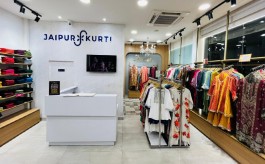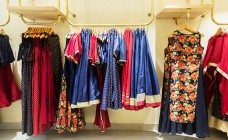More's new food display to serve diverse shopper tastes
By Smita Sinha | January 31, 2019
Aditya Birla Retail’s supermarket chain More recently initiated an interesting approach to food products categorisation based on geography and ethnography. Point-of-Purchase caught up with Manika Mittal, Assistant Vice President, Buying & Merchandising and Priyanka Thapa, Brand & VM Head – Marketing of Aditya Birla Retail Limited, to understand what drove the supermarket chain to do state-wise and country-wise food categorisation.
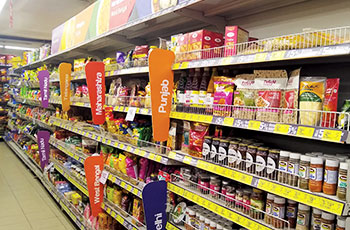 Aditya Birla Retail’s supermarket chain More recently initiated an interesting approach to food products categorisation based on geography and ethnography. The idea was to offer regional and international delicacies that were clearly demarcated for the benefit of the shoppers. Point-of-Purchase caught up with Manika Mittal, Assistant Vice President, Buying & Merchandising and Priyanka Thapa, Brand & VM Head – Marketing of Aditya Birla Retail Limited, to understand what drove the supermarket chain to do state-wise and country-wise food categorisation.
Aditya Birla Retail’s supermarket chain More recently initiated an interesting approach to food products categorisation based on geography and ethnography. The idea was to offer regional and international delicacies that were clearly demarcated for the benefit of the shoppers. Point-of-Purchase caught up with Manika Mittal, Assistant Vice President, Buying & Merchandising and Priyanka Thapa, Brand & VM Head – Marketing of Aditya Birla Retail Limited, to understand what drove the supermarket chain to do state-wise and country-wise food categorisation.
As part of its efforts to curate and offer a varied assortment of regional and international food to its diverse customer under one roof, the Aditya 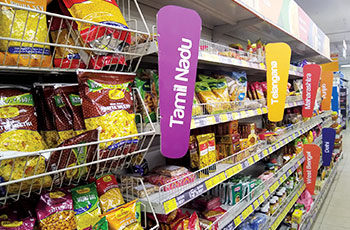 Birla Retail group’s Hypermarket chain More has executed a unique kind of shelving and display system based on state-wise and country-wise food categorisation in its mega stores. The store thus has two shelves with each stocking regional and international food products respectively and they have been named as Foods of India and International Food respectively. In the Food of India category, a customer can find snacks, jelly, pickles and other food items from various regions of India. In the International Foods category, customers can find food ingredients,
Birla Retail group’s Hypermarket chain More has executed a unique kind of shelving and display system based on state-wise and country-wise food categorisation in its mega stores. The store thus has two shelves with each stocking regional and international food products respectively and they have been named as Foods of India and International Food respectively. In the Food of India category, a customer can find snacks, jelly, pickles and other food items from various regions of India. In the International Foods category, customers can find food ingredients,
chocolates and other products from Thailand, Mexico and a host of other countries.
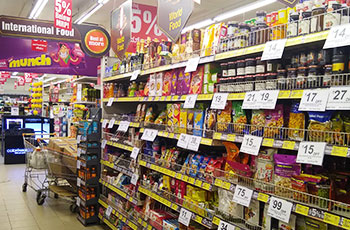 For the Foods of India category, More is associated with 20-30 traditional vendors to provide various regional delicacies to its customer. According to the retail company, the Foods of India categorisation was in direct response to address shoppers’ need for food items from their respective regions. The International Foods section was conceptualised based on the evolving palate of the cosmopolitan consumer who is increasingly turning global in her food habits.
For the Foods of India category, More is associated with 20-30 traditional vendors to provide various regional delicacies to its customer. According to the retail company, the Foods of India categorisation was in direct response to address shoppers’ need for food items from their respective regions. The International Foods section was conceptualised based on the evolving palate of the cosmopolitan consumer who is increasingly turning global in her food habits.
Catering to diverse ethnographies
Elaborating on what drove the retail hypermarket chain to execute this 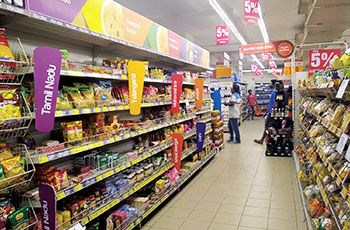 categorisation Manika Mittal, Assistant Vice President, Buying & Merchandising, Aditya Birla Retail Limited told Point-of-Purchase, “Customer-centricity has always been the motto at More. From the various feedback we got from customers we realised that there was a gap in the representation of regional brands or variants and international cuisines. We often got feedback from our front-end team about customers asking for a ‘Jharna’ ghee, ‘Thokku’ pickles or Thai/Mexican ingredients. Moreover, as a retailer we evaluated what differentiated us from competition and then we decided to launch Foods of India and International Foods a year back. The idea was to offer relevant curated
categorisation Manika Mittal, Assistant Vice President, Buying & Merchandising, Aditya Birla Retail Limited told Point-of-Purchase, “Customer-centricity has always been the motto at More. From the various feedback we got from customers we realised that there was a gap in the representation of regional brands or variants and international cuisines. We often got feedback from our front-end team about customers asking for a ‘Jharna’ ghee, ‘Thokku’ pickles or Thai/Mexican ingredients. Moreover, as a retailer we evaluated what differentiated us from competition and then we decided to launch Foods of India and International Foods a year back. The idea was to offer relevant curated 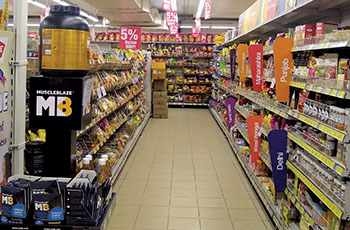 assortment to the consumer under one roof.”
assortment to the consumer under one roof.”
Explaining more on the kind of shopper insights the retailer gleaned, Mittal said, “At More we keep conducting regular focus group studies to understand our consumer and stay relevant. One of the studies was conducted in Bangalore to understand the food habits of our customers. We realised that our customers belonged to very diverse ethnographies and their food habits do not change even when they move to another city. However, there was no one-stop solution to their need for authentic brands and variants.”
 Interestingly, with this format of categorisation More is not only providing consumers with brands they are familiar with, but also encouraging them to try out new delicacies from other regions. According to a Global Data’s survey, globally three quarters of consumer agree that they enjoy experimenting with products from different cultures and cuisines. It has even stated that younger consumers are the most experimental demographics. Nearly four out of five millennials globally say they enjoy experimenting with foreign products.
Interestingly, with this format of categorisation More is not only providing consumers with brands they are familiar with, but also encouraging them to try out new delicacies from other regions. According to a Global Data’s survey, globally three quarters of consumer agree that they enjoy experimenting with products from different cultures and cuisines. It has even stated that younger consumers are the most experimental demographics. Nearly four out of five millennials globally say they enjoy experimenting with foreign products.
“From our customer research we also found out that the consumer is willing to try different tastes and products along with their regional specialities. As customers are starting to experiment with food, it just gives us more opportunity to expand this,” she opined.
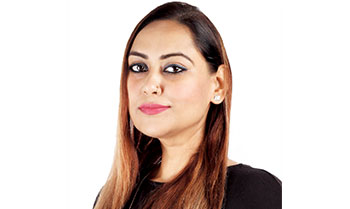 Design & Execution
Design & Execution
Both the shelves have been designed and executed by the internal brand team of More. Explaining the concept design and execution process, Priyanka Thapa, Brand & VM Head -Marketing, Aditya Birla Retail Limited said, “We don’t outsource any creative work. The whole process from conceptualization to design strategy to execution was done by our brand team. In order to make the concept stand out, we first carved out space for our existing elements. We wanted to give the categories prime space where it is easy for the consumer to notice it.”
“The VM was designed based on what is called the 1-2-3 zone Communications Hierarchy approach. Zone 1 – is the department or wayfinding, Zone 2 is the category or sub category and Zone 3 is about education, inspiration, price point communication, etc. For example, on the Foods of India shelf, Zone 2 was used as bay highlighters and fins to highlight the region or state, the products belonged to, while in Zone 3 we used wobblers to highlight key brands or variants or the USP of that brand. Both the categories are under our property called ‘Best of More’. That’s the call-out in Zone 1 as well,” Thapa explained.
The International Food shelve subsumes premium colors like gold, bronze and browns, while the Food of India shelf has a richer and brighter colour scheme.
Talking about the obstacles in scaling both the models, Mittal said, “Both the concepts are doing well especially the international foods section, but the scaling both the models is very difficult owning to the nature of the suppliers. The Food of India suppliers are traditional and fragmented who are not used to doing business with modern trade. Getting them on board and to be able to maintain consistency in supply and quality has been a challenge for both the concepts.”
“However, the local brands are very enthusiastic about the concept. It is an opportunity to get visibility and get their presence felt in geographies other than their own region. We get a brands showing interest in wanting to be part of the concept, but we are very particular about getting the right brands on-board as we want the category to be very authentic,” Mittal added.
While Thapa did not reveal the sales figures, she did admit that the new concept had increased sales of the products.
“It definitely is incremental revenue for us, given that we have carved out a separate space for it, and the VM’s we have done to attract the consumers. We also run promotional offers from time to time and market the concept through newspaper pamphlets every month, besides SMS marketing to the relevant target group and flash sale on key items from time to time,” Thapa said.

